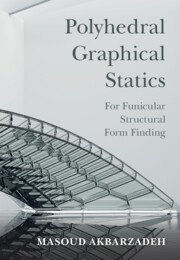Book contents
- Frontmatter
- Dedication
- Contents
- Contributors
- Foreword
- Foreword
- Preface
- Acknowledgments
- Introduction: A Brief History
- 1 Equilibrium of a Single Node
- 2 Equilibrium of a System of Forces
- 3 Compression-Only Form Finding
- 4 Articulated Compression-Only Forms
- 5 Systems with Combined Tension and Compression
- 6 Geometric Degrees of Freedom in Design of Form and Force Diagrams
- 7 Algebraic Formulation for Polyhedral Graphic Statics
- 8 Broader Applications of Polyhedral Graphic Statics
- References
- Index
- References
References
Published online by Cambridge University Press: 13 March 2025
- Frontmatter
- Dedication
- Contents
- Contributors
- Foreword
- Foreword
- Preface
- Acknowledgments
- Introduction: A Brief History
- 1 Equilibrium of a Single Node
- 2 Equilibrium of a System of Forces
- 3 Compression-Only Form Finding
- 4 Articulated Compression-Only Forms
- 5 Systems with Combined Tension and Compression
- 6 Geometric Degrees of Freedom in Design of Form and Force Diagrams
- 7 Algebraic Formulation for Polyhedral Graphic Statics
- 8 Broader Applications of Polyhedral Graphic Statics
- References
- Index
- References
- Type
- Chapter
- Information
- Polyhedral Graphical StaticsFor Funicular Structural Form Finding, pp. 531 - 547Publisher: Cambridge University PressPrint publication year: 2025

